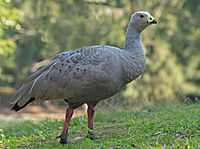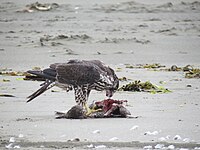Neptune Islands Conservation Park
| Neptune Islands Conservation Park South Australia | |
|---|---|
| Nearest town or city | Port Lincoln[2] |
| Coordinates | 35°16′51″S 136°05′38″E / 35.28083°S 136.09389°E |
| Established | 16 March 1967[3] |
| Area | 145.7 km2 (56.3 sq mi)[2] |
| Managing authorities | Department for Environment and Water |
| See also | Protected areas of South Australia |
Neptune Islands Conservation Park is a
Description
The conservation park includes all the islands within the group with the exception of all or part of the southernmost island (known as Lighthouse Island) in the South Neptune Islands where land has been reserved for ongoing use by a
History
Part of the island group was proclaimed as a fauna conservation reserve under the Crown Lands Act 1929-1966 on 16 March 1967 mainly to conserve the
The conservation park was subsequently extended in 1997 to include the waters within 2 nautical miles (4 km) of the shoreline of both the North and South Neptune Islands via a declaration under the
1n 1990, most of Lighthouse Island was reportedly added to the conservation park after the conversion of the lighthouse to automatic operation with the exception of some land around the lighthouse and an associated helicopter landing site.[7]
On 29 November 2012, the waters within 2 nautical miles (4 km) of the coastline of both the North and South Neptune Islands at median high water also became part of a protected area known as the Neptune Islands Group (Ron and Valerie Taylor) Marine Park.[8][9] The marine park entity provides a level of regulation additional to that of the conservation park in respect to the use of the waters adjoining both groups of islands.[10]
Visitor services
Since 2002, the conservation park is the only venue in Australia where the use of shark cage diving to view great white sharks is legally permitted.
Gallery
Fauna intended to be protected by the declaration of the conservation park in 1967:
-
New Zealand fur seal
-
Australian sea lion
-
Cape Barren goose
-
White-bellied sea eagle
-
Osprey
-
Peregrine falcon
References
- ^ a b "Terrestrial Protected Areas of South Australia (refer 'DETAIL' tab )". CAPAD 2016. Australian Government, Department of the Environment (DoE). 2016. Retrieved 21 February 2018.
- ^ a b "Protected Areas Information System – reserve list (as of 17 Feb 2014)" (PDF). Department of Environment Water and Natural Resources. p. 5. Retrieved 16 March 2014.
- ^ a b "CROWN LANDS ACT, 1929-1966: FAUNA CONSERVATION RESERVES DEDICATED" (PDF). THE SOUTH AUSTRALIAN GOVERNMENT GAZETTE. Government of South Australia. 16 March 1967. pp. 961–962. Retrieved 5 February 2018.
- ^ a b Baker, J.L (2004). Towards a System of Ecologically Representative Marine Protected Areas in South Australian Marine Bioregions – Technical Report. Part 4 (PDF). Department for Environment and Heritage, South Australia. p. 456.
- ^ "National Parks and Wildlife Act 1972" (PDF). Government of South Australia. p. 87 of 159. Retrieved 22 March 2014.
- ^ "NATIONAL PARKS AND WILDLIFE ACT 1972, SECTION 29 (3): NEPTUNE ISLANDS CONSERVATION PARK, SIR JOSEPH BANKS GROUP CONSERVATION PARK, THE PAGES" (PDF). THE SOUTH AUSTRALIAN GOVERNMENT GAZETT. South Australian government. 24 December 1997. p. 1867. Retrieved 6 February 2018.
- ^ Robinson, A. C.; Canty, P.; Mooney, T.; Rudduck, P. (1996). "South Australia's offshore islands" (PDF). Australian Heritage Commission. pp. 131–132. Retrieved 13 December 2013.
- ^ "Neptune Islands Group Ron and Valerie Taylor Marine Park Management plan summary" (PDF). Department of Environment, Water and Natural Resources. Retrieved 12 March 2013.
- ^ "South Australian Marine Parks take effect today" (PDF). South Australian Government. Archived from the original (PDF) on 24 September 2015. Retrieved 29 November 2012.
- ^ "NEPTUNE ISLANDS GROUP (Ron and Valerie Taylor) MARINE PARK MANAGEMENT PLAN 2012" (PDF). Department of Environment Water and Natural Resources. pp. 5 & 11. Retrieved 13 December 2013.
- ^ Huveneers, C.; Rogers, P.J.; Semmens, J.; Beckmann, C.; Kock, A.A.; Page, B.; Goldsworthy, S.D (2012). Effects of the Shark Shield™ electric deterrent on the behaviour of white sharks (Carcharodon carcharias). Final Report to SafeWork South Australia (PDF). Adelaide: South Australian Research and Development Institute (Aquatic Sciences). p. 15.
- ^ "Shark cage diving". Department of Environment, Water and Natural Resources. Retrieved 22 March 2014.







